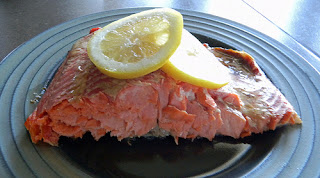I learned to fillet fish, including salmon, in a very busy restaurant in Cherbourg, Normandy, where the required rate was something like one whole fish every 10 seconds, including gutting and cleaning.
We used razor sharp filleting knives that were kept so with a few wipes on a steel from time to time and the fillets on thicker fish such as cod and salmon were removed with just four strokes. You may well take a little longer to start with, but once you've got the hang of it you will find it every easy to do.
The method for salmon was (and still is in my home); hold the whole fish by the head with its back towards you. Insert the knife into the back at the head end until the tip reaches the backbone and twist the handle slightly so that the blade is lying against the bones at a cutting angle of about 10 degrees. Then run it quickly down to the tail, keeping the blade in contact with backbone and dorsal bones. You will both feel the knife blade bounce over these and hear it rasp against them.
Flip the fillet away from you exposing the backbone and hold it clear in your free hand as you cut down and away from you, again keeping the knife blade close to the rib bones. Repeat on the other side.
Remove the skin by dipping your lazy hand in salt and use that to grip the thin end of the fillet, skin side down. Cut down and away close to your hand. The fillet will lift away from the skin quite easily and give you a bit more purchase. Hold the knife blade at an angle of around 10/15 degrees so the blade remains in contact with the skin and run it swiftly to the thick end, while firmly pulling the skin in the opposite direction.
To remove the pin bones, lie the fillet skin side down and run the tips of your fingers from the tail to the head end. You will easily feel them poking up through the flesh. I find the easiest way to remove them is to use a pair of eyebrow tweezers.
The carcass and skin, including the head, can be used for stock, but use kitchen scissors to remove the pink gills before doing so. They can impart a bitter taste to any liquid when heated.
We used razor sharp filleting knives that were kept so with a few wipes on a steel from time to time and the fillets on thicker fish such as cod and salmon were removed with just four strokes. You may well take a little longer to start with, but once you've got the hang of it you will find it every easy to do.
The method for salmon was (and still is in my home); hold the whole fish by the head with its back towards you. Insert the knife into the back at the head end until the tip reaches the backbone and twist the handle slightly so that the blade is lying against the bones at a cutting angle of about 10 degrees. Then run it quickly down to the tail, keeping the blade in contact with backbone and dorsal bones. You will both feel the knife blade bounce over these and hear it rasp against them.
Flip the fillet away from you exposing the backbone and hold it clear in your free hand as you cut down and away from you, again keeping the knife blade close to the rib bones. Repeat on the other side.
Remove the skin by dipping your lazy hand in salt and use that to grip the thin end of the fillet, skin side down. Cut down and away close to your hand. The fillet will lift away from the skin quite easily and give you a bit more purchase. Hold the knife blade at an angle of around 10/15 degrees so the blade remains in contact with the skin and run it swiftly to the thick end, while firmly pulling the skin in the opposite direction.
To remove the pin bones, lie the fillet skin side down and run the tips of your fingers from the tail to the head end. You will easily feel them poking up through the flesh. I find the easiest way to remove them is to use a pair of eyebrow tweezers.
The carcass and skin, including the head, can be used for stock, but use kitchen scissors to remove the pink gills before doing so. They can impart a bitter taste to any liquid when heated.
Michael Sheridan - The Cool Cook - is a former head chef and an acknowledged authority and published writer on cooking matters. His website at All About Cooking, contains a wealth of information, hints, tips and recipes for busy home cooks, including video based how-to guides.
